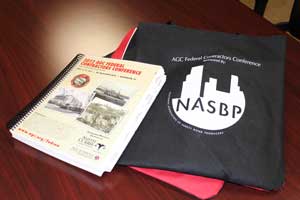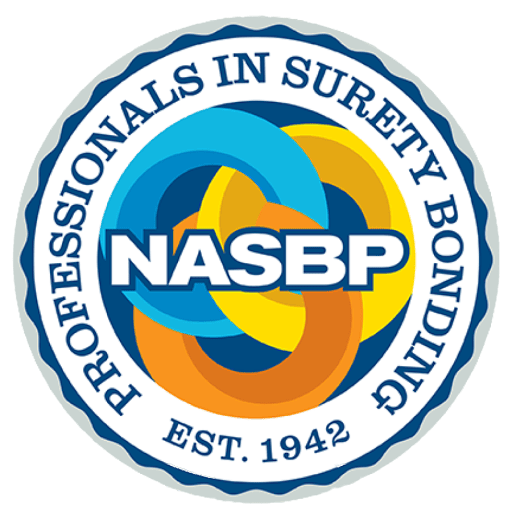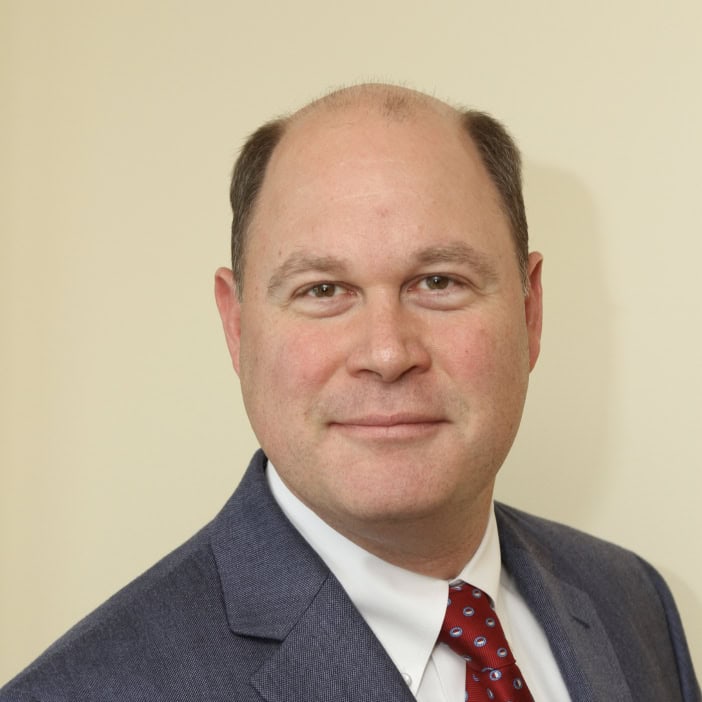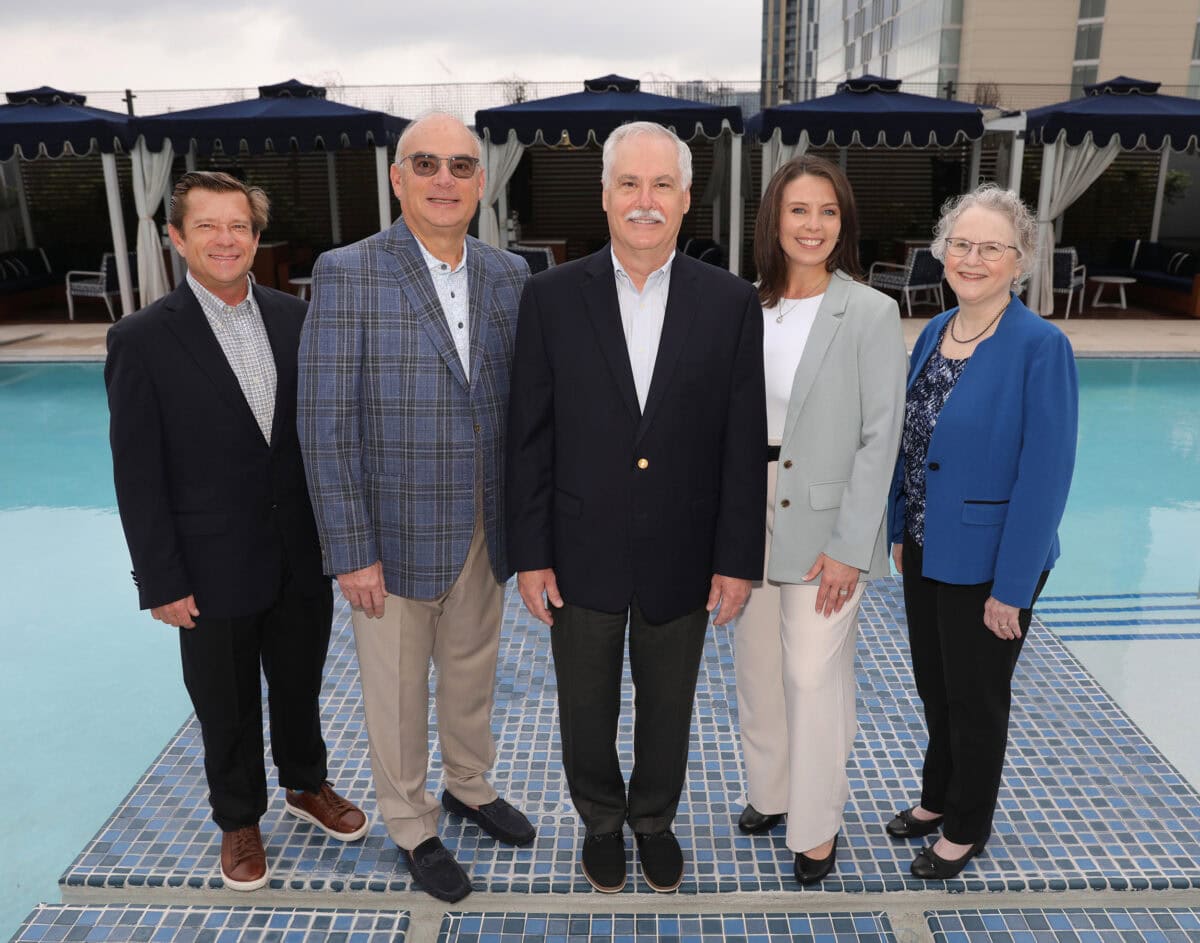 Each year AGC has a wonderful conference in Washington DC for their contractors doing federal work. The conference brings together AGC members and most, if not all the federal contracting agencies. While we witness the issues our customers have with their owners through their financial results and we hear the stories at our meetings, we rarely have the opportunity to watch them skillfully work through those issues unless the situation is bad and we are summoned to the table. FedCon gives us one such opportunity. NASBP has been, and continues to be, a leading sponsor of the event. The NASBP logo was emblazoned on the meeting’s tote bag (picture here) provided at registration.
Each year AGC has a wonderful conference in Washington DC for their contractors doing federal work. The conference brings together AGC members and most, if not all the federal contracting agencies. While we witness the issues our customers have with their owners through their financial results and we hear the stories at our meetings, we rarely have the opportunity to watch them skillfully work through those issues unless the situation is bad and we are summoned to the table. FedCon gives us one such opportunity. NASBP has been, and continues to be, a leading sponsor of the event. The NASBP logo was emblazoned on the meeting’s tote bag (picture here) provided at registration.
As I write this, the conference hasn’t yet concluded; however, there already is and continues to be news to share…both about industry trends and industry misperceptions.
During the presentation made by the Federal Highway Administration, information was shared about an effort to try and find ways to deal with their budget constraints. The FHA hired a graduate student to research the money spent on bonds and the benefit received. This graduate student concluded that because there was only a very small percentage of contractor failures (under 2%) and some $680 million or thereabouts in premium dollars spent on bonds, the money would be better spent elsewhere. The recommendation was made for the Federal Highway Administration to do the qualification work the bonding companies would ordinarily perform and no longer require bonds in the future. Such recommendations clearly evidence a lack of understanding of the product, the surety process, and its value. I am sure they have little knowledge of what sureties do behind the scenes to keep projects on track and to avoid defaults.
Fortunately, one of my colleagues and a couple of seasoned Travelers surety underwriters were in the room to speak up on our industry’s behalf, explaining the surety’s role in pre-qualification so those results were possible, the role of the payment bond when liens can’t be filed against public property, etc. We even had some contractor members defend sureties and surety bonding. Unfortunately, the agency may be pretty far down the road with their study and their conclusions. Obviously, we, as an industry, have some education to do with this federal agency.
It is easy to say “NASBP staff will deal with it”…so it isn’t my problem to worry about. Our Government Relations staff is just a couple of people. They are dealing with issues relating not only at the Federal level, but with all 50 states and U.S. Territories as well as other industry issues. They do a great job for us, but there are so many attacks on our product on so many fronts (did you see this week’s Wall Street Journal/SmartMoney.com article for one?)…we need all hands on deck.
There are consistent themes of challenges running through all of the reports of the federal agencies budget constraints and an ever-changing workforce as fewer Federal dollars are available for construction. Agencies have limited resources, which affects us and our customers in many ways. They are all struggling to prioritize the projects that need to be tackled first. Most federal facilities, regardless the agency, average between 50-60 years in age. Old buildings and aging infrastructure cause big worries.
All federal agencies are struggling to get the most bang for their buck. They are using project delivery methods where “technically qualified lowest price” now drives the best value selection process. When the workforce needs to be reduced, it is the older, more seasoned employees familiar with our product and its value who are retiring or leaving to pursue opportunities outside government service. Younger people are hired, but what training are they receiving? Does it include surety issues? It is clear there is a need for procurement workforce training that includes education on surety.
We raise the contract bundling issue each time we go to visit our Members in Congress; however, the agencies say they must have the contract bundling tool to be able to manage the work. It is a constant issue for middle market contractors, who raise their voices in forums such as this conference to educate federal agencies. They are being shut out of projects because work is either set aside for small or disadvantaged businesses, allocated for priority mega projects or bundled in large MATOCs, MACC’s or IDIQ type delivery methods. If middle market companies don’t get work, we don’t get to write bonds to guarantee those contracts, not to mention what it will do to the economy or to our own industry results.
Additional privatization is a reality we will see become more prevalent and quickly, because there are insufficient budget dollars to do all the work that needs to be done. On the screen yesterday, they showed all future medical office building (MOB) projects on the table for the VA will be Leased Public Private Partnership (P3) delivery method. Their MOB program for all of their medical office buildings, including out-patient surgery centers ranging in size from $20 million to $180 million will be long-term leaseback P3’s where financing and design gets brought to the table, along with construction. Typically, the VA has the site selected and acquires an option on the land, and the chosen team purchases it, then finances, designs and builds the facility, owning and operating it in the future with a 20-year leaseback from the VA. Most of the smaller work is set aside for veteran-owned and service-disabled, veteran-owned businesses.
There isn’t enough money to build needed facilities the traditional way, military family housing in the U.S. has already been privatized…quite successfully. Now we will see this delivery method become much more prevalent whether we are talking about buildings for the GSA, the VA or other agencies. Will they understand the need to continue to require bonding on these projects?
The various mentor-protégé and teaming arrangements have been a big topic here with the SBA. It is a relevant issue for both large and small businesses. There is confusion among the groups about how the various programs are managed and which agency has oversight. All groups are seeking clarity, so contractors are educated about the governing rules in order to stay out of the crosshairs of the Justice Department. I was encouraged to hear both the SBA and the VA recognize the need for such clarity, and discussion is taking place about the potential to merge existing programs to help contractors avoid getting caught in the middle.
While it is a pleasure to attend a wonderful event like FedCon where NASBP and bond producers are well-regarded, it serves to remind us the construction industry has many challenges. It’s only going to get worse. I believe there will be many times when we will be required to do the explaining on why surety bonds are not the problem.
It is incumbent upon us to connect the dots for everyone about the value of our product. There are many influences affecting contract procurement which affect our customers and their ability to compete, survive, and thrive. We must take personal responsibility for education stakeholders. You benefit from this wonderful industry and you have a voice. Use it. Get involved and communicate with your colleagues and NASBP staff to let them know what you have done. They constantly need examples of our individual advocacy and examples where our product is benefiting the taxpayer.
We hope to see you in Washington the last week of June and suggest you bring an industry friend. We have a great line-up of the Regions 8, 9, 10 and 11 Meeting here in Washington, D.C. to be immediately followed by the Legislative Fly-in and a Government Contracting Workshop. You can attend all the events or whatever best suits your needs. We need attendees here for the Fly-in on Tuesday to keep up the momentum gained from the prior three years of advocacy.
Use SuretyConnect to coordinate with your industry friends from the same state or Region, and if you can’t come, send someone from your company. Meet your representatives in a group. It carries more impact, is less intimidating, and makes it easier to set up the appointments and besides…it’s fun. Hope to see you in Washington.
 The author of this article is NASBP’s Government Relations Committee Chair Susan Hecker, Area Executive Vice President, Gallagher Construction Services in San Francisco, California.
The author of this article is NASBP’s Government Relations Committee Chair Susan Hecker, Area Executive Vice President, Gallagher Construction Services in San Francisco, California.
Get Important Surety Industry News & Info
Keep up with the latest industry news and NASBP programs, events, and activities by subscribing to NASBP Smartbrief.




